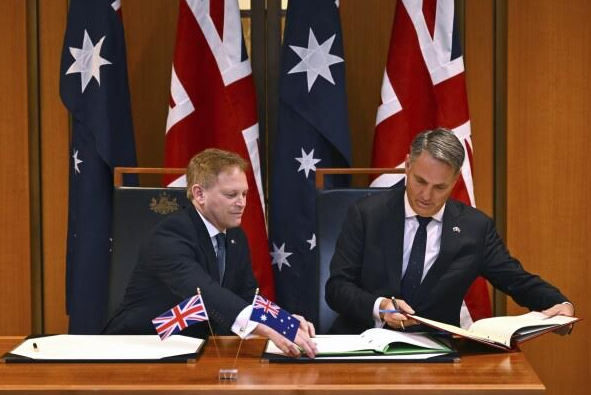
Australia and Britain have strengthened their strategic cooperation through a Defence Treaty that includes collaboration under the AUKUS nuclear submarine pact.
The two countries signed a treaty to bolster cooperation over the next 50 years as part of the AUKUS nuclear submarine partnership.
The AUKUS pact, agreed upon by Australia, Britain, and the U.S. in 2021, aims to provide Australia with nuclear-powered attack submarines from the next decade to counter China’s ambitions in the Indo-Pacific. Earlier this year, the U.S. administration announced a formal review of the pact.
The treaty was described as “a commitment for the next 50 years of UK-Australian bilateral defence cooperation under AUKUS Pillar I,” adding that it builds on the “strong foundation” of trilateral AUKUS cooperation.
Britain’s Ministry of Defence said the bilateral treaty would underpin the two allies’ submarine programmes and could be worth up to 20 billion pounds ($27.1 billion) in exports for Britain over the next 25 years.
It is expected that Prime Minister Keir Starmer will continue the policies of the earlier Conservative government regarding alliance strategy in the Indo-Pacific, alongside the United States, including AUKUS cooperation.
The United Kingdom is arguably the most direct beneficiary of AUKUS cooperation. The project promises the UK a critical future submarine capability, continuity of production, Australian investment in its industrial base, access to U.S. technologies, and burden-sharing with partners on cost and workforce challenges.
Although AUKUS is often described by commentators as an Australia–U.S. initiative, Australia benefits greatly from the UK’s involvement. Britain brings to Australia’s AUKUS programme its extensive experience in submarine design and construction, major industry players, enhanced collective bargaining power in Washington, and tangible support for Australia’s vision of a balanced power structure in the Indo-Pacific.
AUKUS is Australia’s largest-ever defence project, with Canberra committing A$368 billion over three decades. The programme includes billions of dollars of investment in the U.S. production base.
Australia, which earlier paid A$800 million to the U.S. as the second instalment under AUKUS, has maintained confidence that the pact will proceed.
Previously, the defence and foreign ministers of Australia and Britain held talks in Sydney to boost cooperation, coinciding with Australia’s largest war games.
Around 40,000 troops from 19 countries participated in the Talisman Sabre exercises from July 13 to August 4, which the Australian military described as a rehearsal for joint warfare aimed at maintaining stability in the Indo-Pacific.
The SSN-AUKUS submarine will incorporate technology from all three AUKUS nations. It will be built in northern England for the UK Royal Navy, while Australia plans to build its own in South Australia for delivery to the Royal Australian Navy in the 2040s. The treaty has yet to be released publicly and will soon be tabled in parliament.
AUKUS is expected to become a cornerstone of strategic alignment, potentially supplanting the Quad—or vice versa—depending on circumstances.
Australia’s decision to acquire nuclear-powered submarines is notable, given that it is not a nuclear weapons state and has a strong record of promoting nuclear non-proliferation in international forums.
Previously, Australia had planned to work with France to acquire 12 conventional submarines to strengthen its Indo-Pacific force structure. The shift towards nuclear-powered submarines can be seen as a response to China’s growing maritime presence in the region.
Australia’s move aims to boost its deterrence capability, and with U.S. support, the choice of nuclear propulsion is understandable. The 12 conventional submarines initially planned were to replace the existing six Collins-class submarines.
Canberra’s pursuit of new submarines is not new—it has been discussed for over a decade. Changes in government have not altered this trajectory, reflecting a sense of strategic continuity.
The Australian Defence White Papers of 2009, 2012, and 2013, which were predominantly conservative regarding procurement issues, raised questions about Canberra’s strategic orientation and active posturing.
While the submarine programme is primarily focused at the operational level, it has strategic implications. The submarines are expected to be based with Australia’s Western Fleet in Perth, oriented towards the Indian Ocean and with responsibilities in the South-West Pacific. This contrasts with the Eastern Fleet in Sydney, which is focused on the South Pacific but could extend its reach to the South-East Pacific.
Australia’s submarine acquisition strategy considers China’s growing and increasingly sophisticated submarine force, which includes advanced conventional-powered boats and improved nuclear-powered vessels.
Currently, China possesses 53 diesel attack submarines, five nuclear attack submarines, and four nuclear ballistic missile submarines.
While Chinese submarine activity is less prominent in the South Pacific than in the Indian Ocean and South-West Pacific—Canberra’s main areas of concern—China is expected to expand its fleet. Plans include introducing new guided-missile attack submarines, commissioning up to 20 Yuan-class air-independent propulsion submarines, and enhancing the capability of nuclear attack submarines.
This represents a formidable mix of conventional and nuclear capabilities, making China’s submarine force the largest in Asia, with increasing capacity for long-range operations in both the Indian Ocean and South Pacific.
The question of whether Canberra can forgo nuclear submarines has been raised before, notably in the November 2013 U.S. Centre for Strategic and Budgetary Assessments study of the ANZUS Treaty. That report concluded there was a stronger case for nuclear submarines than for conventional replacements for the Collins class.
Australia has operated six submarines for much of the past 35 years—initially six British-designed Oberon-class boats, which were replaced between 1996 and 2003 by the Collins class.
In parallel, Australia is enhancing its anti-access and area-denial capabilities to counter the Russian Pacific Fleet, which has resumed long-range patrols, including in the Pacific Islands.
Canberra is also acquiring P-8 long-range surveillance aircraft, three air warfare destroyers, and future frigates with advanced anti-submarine warfare capabilities to replace the Anzac-class vessels.
In conclusion, Australia and the United Kingdom are expected to maintain strong strategic cooperation both within and beyond the AUKUS framework in the years ahead.
Leave a Reply